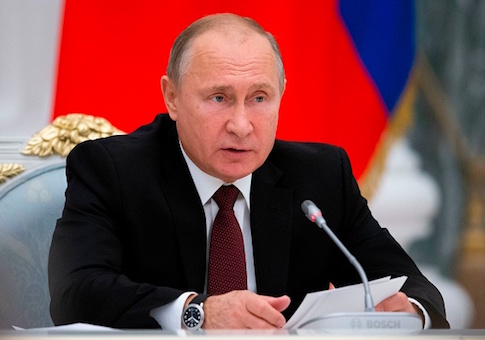KIEV, Ukraine—News reports from Russian media over the weekend indicate that the hypersonic cruise missile highlighted in President Vladimir Putin's Feb. 20 state of the nation address is being contemplated for use in a first strike against targets in the continental United States.
This was the second year in a row that the Russian leader used the occasion of his annual presentation to a joint session of the Russian state parliament to threaten the use of nuclear-capable, "doomsday" weapons against the United States.
Putin highlighted the NPO Mashinostroyeniya 3M22 Tsirkon missile. It has a range of about 620 miles, which means it would have to be launched from a ship or submarine very close to the U.S. east or west coast if it were to be fired at targets in the continental United States, according to Russian weapons design specialists who spoke to the Washington Free Beacon.
"In a wartime situation, no Russian naval vessel could approach this close to the U.S. and still survive, so the only interpretation is that Tsirkon is now being planned as a first strike weapon. The only plausible scenario is one in which these ships or subs would approach an unsuspecting U.S. coastline and then the Tsirkons would be launched in a surprise attack," said one expert.
Dmitry Kiselyov, host of Russia's "News of the Week," outlined the targets that the missile would be used against on his weekly TV show. Kiselyov has garnered international attention for a series of bombastic statements, which include telling his audience in March 2014 that the world should be grateful for the fact that "Russia is the only country in the world that is realistically capable of turning the United States into radioactive ash."
The targets, according to Kiselyov, are some of the main U.S. strategic command centers, as well as those installations where in a time of crisis senior U.S. government staff would be relocated in order to maintain the continuity of government. These include the Pentagon, Camp David, and Fort Ritchie on the east coast and McClellan Air Force Base and Jim Creek, a central U.S. Navy communications station in Washington, on the west coast.
Kiselyov said the Tsirkon hypersonic cruise missile could hit these targets in less than five minutes if launched from submarines.
It is unclear how realistic the statements of Putin or Kiselyov are—and how soon the Tsirkon missile could be prepared for deployment.
Putin said the development costs for the Tsirkon would be minimized because it is compatible with the Novator-made Kalibr cruise missiles already installed on Russian ships and submarines. However, Novator are made at a completely separate design facility, so claims of "compatibility" between the two missile systems are dubious.
Some observers say the decision to highlight the Tsirkon being employed against high-value targets is not a new and bold move by the Russian military. One former Russian military aerospace designer said, "these sites have long been on the first priority target lists for the Russian ICBM fleet and have always been set for destruction by Russia's nuclear forces."
"But, Kiselyov now waving the flag and publicly identifying these command centers makes it look like Russia is now safer and more capably defended—as well as on the offensive—in a way not previously seen," he continued.
"It is another example of this Kremlin propaganda team pumping up Putin's image—and making it look like these wonder weapons that do not even really exist were only capable of being built because of Putin's 'decisive and fearless leadership.'"
Mark Schneider, a former Pentagon policymaker involved in nuclear arms, said the threat by Putin was unprecedented. "This is Putin’s first nuclear targeting threat directed specifically against the U.S.," Schneider told the Washington Times.
Dmitry Peskov, Russian presidential spokesman, sought to clarify Putin's comments following the Russian television report identifying targets. The comment, however, appeared to confirm the Russian leader's threat.
"The president said that if our country is under threat and intermediate and shorter range missiles are deployed near its borders, a proportionate response will have to be made and our missiles targeted not only at the launchers, but at the territories where the center of decision-making is located. Please remember that the president did not mention a single geographic name in this connection," Peskov said on Monday, according to the state-run TASS news agency.
Peskov made the comment when asked about the Rossiya-1 television report identifying targets. "We never intervene in the editorial policies of our television channels, even government-run ones, and we cannot do so," he added.
The Russian leader in his address made the threatening comments stating that Russia would take proportionate and asymmetrical measures if the United States deploys intermediate-range and short-range missiles in Europe and insisted Russian would not be the first to deploy this type of weapon.
The United States has withdrawn from the 1987 Intermediate-range Nuclear Forces Treaty with Russia based on Moscow deploying a new ground-launched cruise missile, the SCC-8, in violation of the treaty that bans missiles with ranges of 300 to 3,400 miles.
